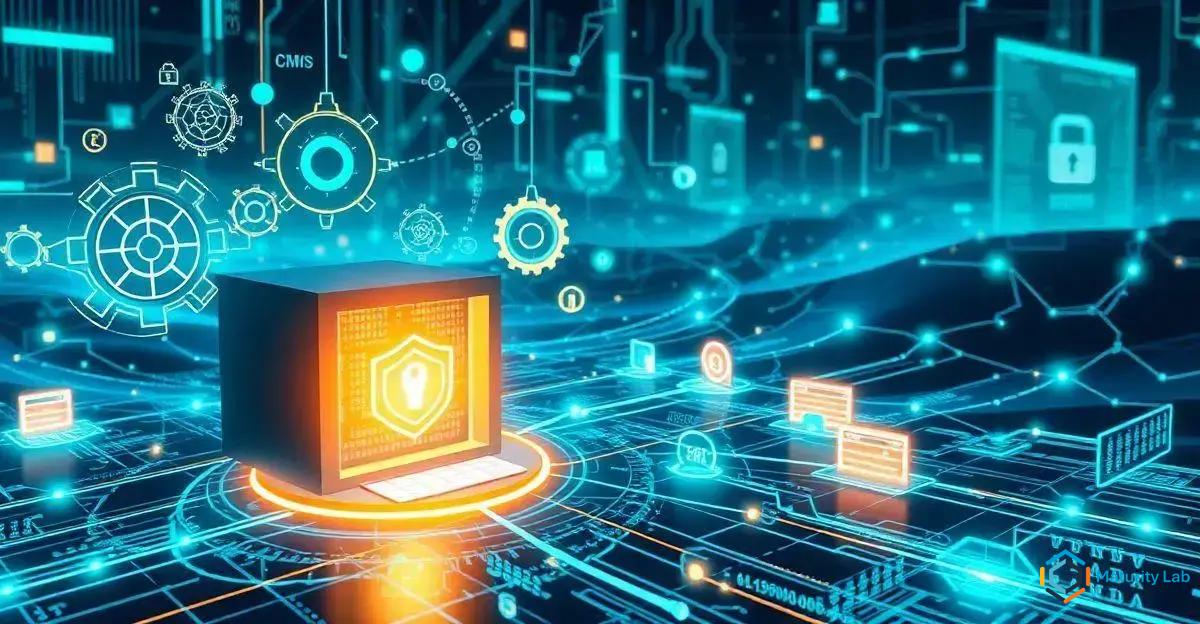The Cybersecurity Capability Maturity Model (C2M2) is a framework developed by the U.S. Department of Energy to help organizations assess and enhance their cybersecurity and data protection capabilities across ten critical domains. It focuses on a risk-based approach, continuous improvement, and strong leadership, enabling businesses to identify vulnerabilities and implement best practices to safeguard their information assets effectively.
In today’s digital age, cybersecurity and data protection are paramount for any organization. The Cybersecurity Capability Maturity Model (C2M2) offers a structured approach to enhancing these critical areas. By leveraging maturity models like C2M2, businesses can systematically assess and improve their cybersecurity practices, ensuring robust data protection. This article delves into the intricacies of the C2M2 framework, its implementation, and how it can be integrated with comprehensive data protection strategies.
Understanding the C2M2 Framework

The Cybersecurity Capability Maturity Model (C2M2) is a comprehensive framework designed to help organizations evaluate and enhance their cybersecurity capabilities. Developed by the U.S. Department of Energy, C2M2 provides a structured approach to assess an organization’s current cybersecurity posture and identify areas for improvement. The model is particularly useful for critical infrastructure sectors but can be adapted to various industries.
At its core, C2M2 is built around ten domains, each representing a critical aspect of cybersecurity. These domains include Asset, Change, and Configuration Management; Threat and Vulnerability Management; and Situational Awareness, among others. Each domain is further divided into objectives and practices that organizations can implement to achieve higher maturity levels.
One of the key features of C2M2 is its maturity indicator levels (MILs), which range from MIL0 to MIL3. These levels help organizations gauge their progress in each domain. For instance, MIL0 indicates that practices are not performed or are performed in an ad hoc manner, while MIL3 signifies that practices are well-documented, consistently followed, and continuously improved.
The C2M2 framework also emphasizes the importance of a risk-based approach to cybersecurity. By identifying and prioritizing risks, organizations can allocate resources more effectively and focus on the most critical areas. This risk-based approach is complemented by the model’s emphasis on continuous improvement, encouraging organizations to regularly review and update their cybersecurity practices.
To illustrate, consider a mid-sized manufacturing company looking to enhance its cybersecurity posture. By using the C2M2 framework, the company can assess its current capabilities across the ten domains, identify gaps, and develop a targeted action plan to address these gaps. This structured approach not only improves the company’s cybersecurity but also ensures that resources are used efficiently.
In summary, understanding the C2M2 framework is the first step toward a more secure and resilient organization. By leveraging its structured approach, maturity indicator levels, and risk-based focus, businesses can systematically enhance their cybersecurity capabilities and protect their valuable data.
Implementing C2M2 for Enhanced Cybersecurity

Implementing the Cybersecurity Capability Maturity Model (C2M2) within an organization requires a methodical approach to ensure effective adoption and tangible improvements in cybersecurity.
The process begins with a thorough assessment of the current cybersecurity posture, which involves evaluating existing practices against the C2M2 domains and maturity indicator levels (MILs).
The initial step in implementation is to establish a baseline by conducting a comprehensive self-assessment. This assessment helps identify the organization’s current maturity levels across the ten C2M2 domains, such as Asset, Change, and Configuration Management, and Threat and Vulnerability Management. By understanding where the organization stands, it becomes easier to pinpoint specific areas that require enhancement.
Following the assessment, the next step is to develop a detailed action plan. This plan should outline specific objectives, practices, and milestones for each domain, tailored to the organization’s unique needs and risk profile. For example, if the assessment reveals deficiencies in Situational Awareness, the action plan might include implementing advanced monitoring tools and establishing a dedicated cybersecurity operations center.
Effective implementation also necessitates strong leadership and governance. Senior management must be actively involved in the process, providing the necessary resources and support. This includes allocating budget for cybersecurity initiatives, appointing a dedicated team to oversee the implementation, and fostering a culture of continuous improvement.
Training and awareness programs are crucial components of the implementation process. Employees at all levels should be educated about the importance of cybersecurity and their role in maintaining it. Regular training sessions, workshops, and simulations can help reinforce best practices and ensure that everyone is aligned with the organization’s cybersecurity objectives.
Monitoring and evaluation are essential to track progress and measure the effectiveness of the implemented practices. Organizations should establish key performance indicators (KPIs) to monitor improvements and conduct periodic reviews to assess the impact of the changes. This continuous feedback loop allows for adjustments and refinements, ensuring that the organization remains on track to achieve higher maturity levels.
Consider a financial institution aiming to bolster its cybersecurity defenses. By implementing C2M2, the institution can systematically address vulnerabilities, enhance threat detection capabilities, and improve incident response procedures. This structured approach not only strengthens the institution’s cybersecurity posture but also builds trust with customers and stakeholders.
In conclusion, implementing C2M2 for enhanced cybersecurity involves a comprehensive assessment, a tailored action plan, strong leadership, continuous training, and ongoing monitoring. By following these steps, organizations can achieve significant improvements in their cybersecurity capabilities and better protect their critical assets.
Integrating Data Protection Strategies with C2M2

Integrating data protection strategies with the Cybersecurity Capability Maturity Model (C2M2) ensures a holistic approach to safeguarding an organization’s critical information assets. Data protection encompasses a range of practices designed to secure data from unauthorized access, corruption, or theft, and aligning these practices with C2M2 can significantly enhance overall cybersecurity resilience.
The first step in this integration is to map data protection requirements to the relevant C2M2 domains. For instance, the domain of Asset, Change, and Configuration Management is crucial for maintaining an accurate inventory of data assets and ensuring that changes to these assets are tracked and managed securely. Similarly, the Threat and Vulnerability Management domain helps identify potential threats to data and implement measures to mitigate these risks.
A key aspect of data protection is ensuring data confidentiality, integrity, and availability (CIA). The C2M2 framework supports these principles through its structured approach to cybersecurity practices. For example, the domain of Identity and Access Management (IAM) focuses on controlling access to data based on user roles and responsibilities, thereby ensuring that only authorized personnel can access sensitive information.
Situational Awareness
Another important domain is Situational Awareness, which involves monitoring and analyzing data-related activities to detect and respond to potential security incidents. By integrating advanced monitoring tools and techniques, organizations can gain real-time insights into data usage patterns and quickly identify any anomalies that may indicate a security breach.
Data protection also involves robust incident response and recovery procedures. The C2M2 domain of Incident Response, Continuity of Operations, and Recovery provides a framework for developing and implementing these procedures. By aligning data protection strategies with this domain, organizations can ensure that they are prepared to respond effectively to data breaches and minimize the impact on their operations.
Consider a healthcare provider that handles sensitive patient information. By integrating data protection strategies with C2M2, the provider can enhance its ability to secure patient data, comply with regulatory requirements, and maintain patient trust. This might involve implementing encryption for data at rest and in transit, establishing strict access controls, and regularly auditing data access logs.
Additionally, organizations should adopt a risk-based approach to data protection, as emphasized by C2M2. This involves identifying and prioritizing data-related risks and allocating resources to address the most critical vulnerabilities. By doing so, organizations can ensure that their data protection efforts are focused and effective.
In summary, integrating data protection strategies with C2M2 involves mapping data protection requirements to relevant C2M2 domains, ensuring CIA principles, enhancing situational awareness, and developing robust incident response procedures. By adopting this integrated approach, organizations can achieve a higher level of data security and better protect their valuable information assets.
In conclusion, the Cybersecurity Capability Maturity Model (C2M2) offers a robust framework for enhancing an organization’s cybersecurity posture and data protection strategies.
By understanding the C2M2 framework, organizations can systematically assess their current capabilities and identify areas for improvement across its ten domains.
Implementing C2M2 involves a comprehensive self-assessment, a tailored action plan, strong leadership, continuous training, and ongoing monitoring to ensure effective adoption and tangible improvements.
Integrating data protection strategies with C2M2 further strengthens an organization’s ability to safeguard critical information assets.
By mapping data protection requirements to relevant C2M2 domains, ensuring the principles of confidentiality, integrity, and availability, enhancing situational awareness, and developing robust incident response procedures, organizations can achieve a higher level of data security.
Ultimately, leveraging C2M2 enables organizations to adopt a structured, risk-based approach to cybersecurity and data protection.
This not only enhances their overall security posture but also builds trust with customers and stakeholders.
As cyber threats continue to evolve, adopting and integrating maturity models like C2M2 will be essential for organizations striving to protect their valuable data and maintain resilience in an increasingly digital world.
Frequently Asked Questions about C2M2, Cybersecurity, and Data Protection
What is the Cybersecurity Capability Maturity Model (C2M2)?
The Cybersecurity Capability Maturity Model (C2M2) is a framework developed by the U.S. Department of Energy to help organizations assess and enhance their cybersecurity capabilities. It is built around ten domains, each representing a critical aspect of cybersecurity.
How does C2M2 help in improving cybersecurity?
C2M2 helps organizations evaluate their current cybersecurity posture, identify areas for improvement, and implement structured practices to enhance their cybersecurity capabilities. It provides a risk-based approach and emphasizes continuous improvement.
What are the key domains of C2M2?
The key domains of C2M2 include Asset, Change, and Configuration Management; Threat and Vulnerability Management; Situational Awareness; Identity and Access Management; and Incident Response, Continuity of Operations, and Recovery, among others.
How can organizations integrate data protection strategies with C2M2?
Organizations can integrate data protection strategies with C2M2 by mapping data protection requirements to relevant C2M2 domains, ensuring data confidentiality, integrity, and availability, enhancing situational awareness, and developing robust incident response procedures.
What is the role of maturity indicator levels (MILs) in C2M2?
Maturity indicator levels (MILs) in C2M2 range from MIL0 to MIL3 and help organizations gauge their progress in each domain. MIL0 indicates ad hoc practices, while MIL3 signifies well-documented, consistently followed, and continuously improved practices.
Why is a risk-based approach important in C2M2?
A risk-based approach is important in C2M2 because it helps organizations identify and prioritize risks, allocate resources effectively, and focus on the most critical areas. This approach ensures that cybersecurity efforts are targeted and efficient.

